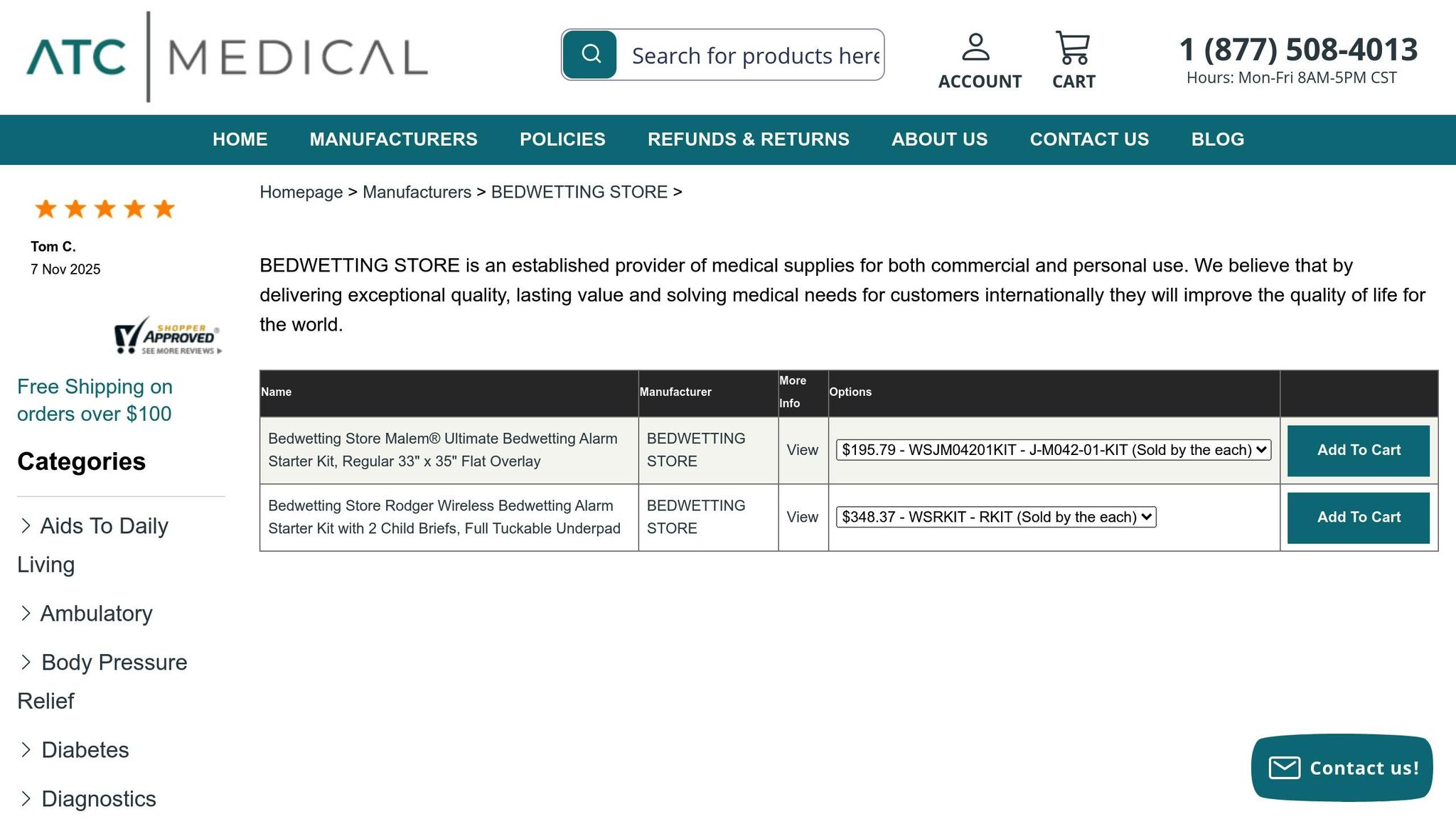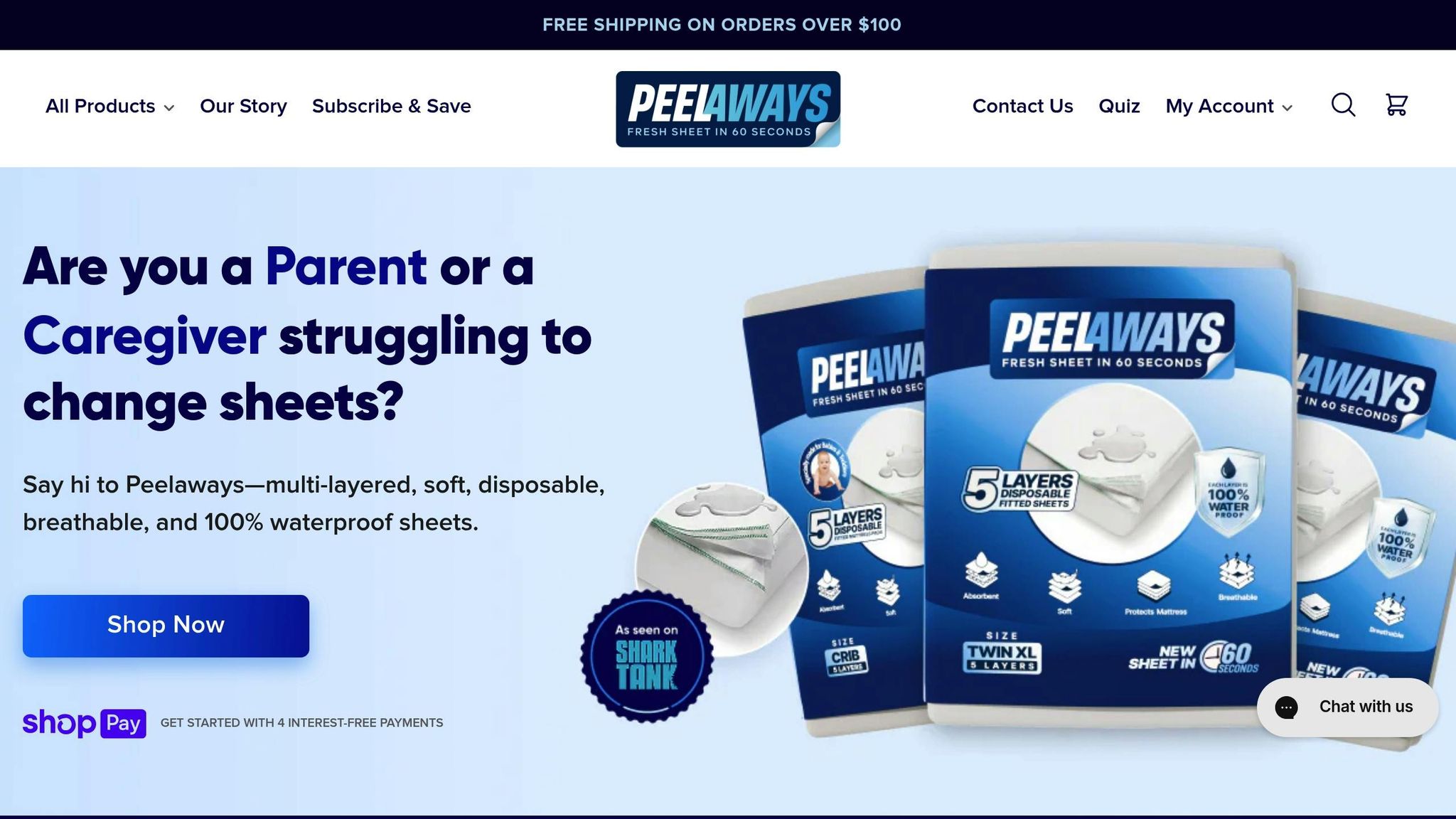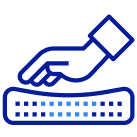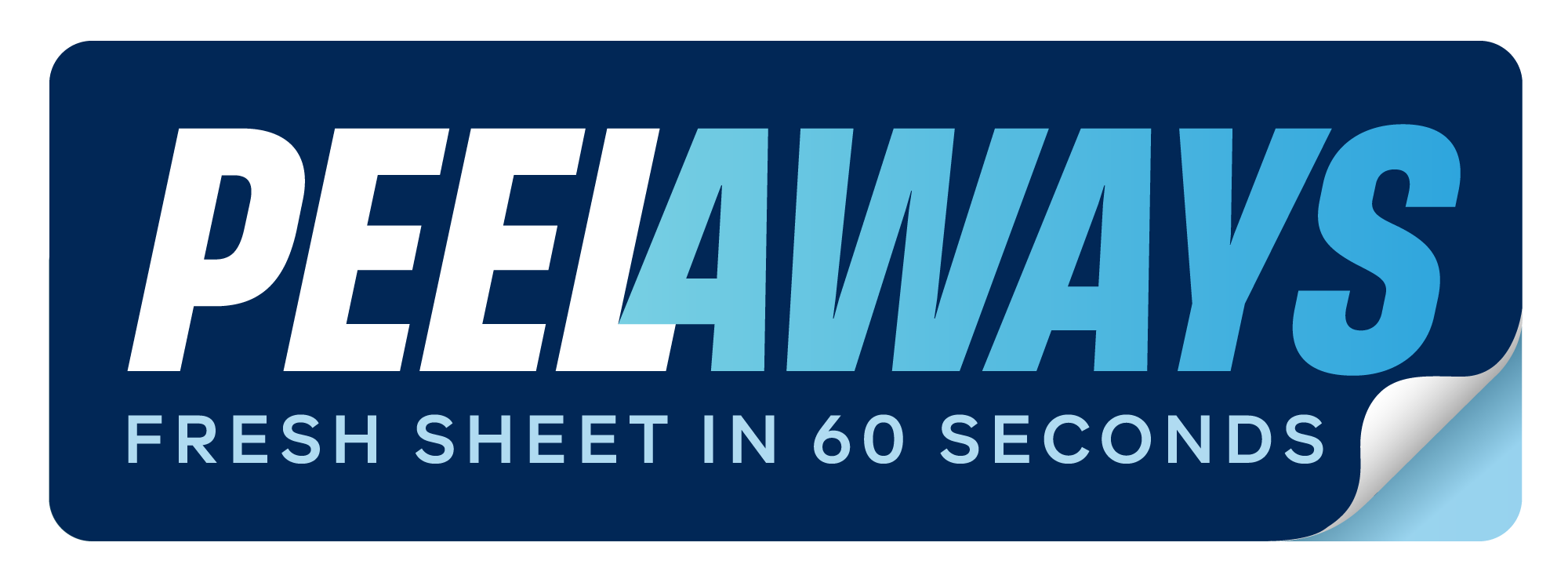Wireless Bedwetting Tools for Elderly Care

Wireless bedwetting tools are designed to make managing incontinence in elderly care easier and more efficient. These systems use sensor pads and wireless alarms to quickly detect moisture and alert caregivers, reducing the physical and emotional strain associated with traditional methods. Pairing these tools with disposable bedding like PeelAways simplifies cleanup, protects skin health, and preserves dignity for elderly individuals.
Key Benefits:
- Fast Alerts: Sensors detect moisture and notify caregivers instantly, allowing quick response.
- Improved Hygiene: Prevents prolonged exposure to moisture, reducing risks of skin irritation and infections.
- Caregiver Convenience: Remote alerts eliminate the need for constant checks, saving time and energy.
- Enhanced Comfort: Wireless systems are compact and discreet, avoiding bulky cords or attachments.
- Simplified Cleanup: Disposable bedding like PeelAways allows for easy removal of soiled layers without heavy lifting or excessive laundry.
Wireless systems typically cost between $49.95 and $69.95, while PeelAways sheets range from $34.99 to $53.99, depending on size. Together, they offer a practical solution for incontinence care in both home and facility settings.
How Wireless Bedwetting Tools Work
Main Parts of Wireless Bedwetting Tools
Wireless bedwetting tools used in elderly care consist of three main components: a moisture sensor, a wireless transmitter, and a receiver. The moisture sensor, often built into bed pads or sheets, detects urine by identifying changes in moisture levels or electrical conductivity. These sensors are designed to be comfortable and easy to position, making them ideal for individuals with limited mobility.
The wireless transmitter plays a key role by instantly sending signals from the moisture sensor. This feature enhances safety and allows caregivers to place the system in a way that best suits the care environment.
Finally, the receiver or alarm notifies caregivers when moisture is detected. Alerts can take the form of sound, light, or vibrations. Receivers are versatile - they can be placed in caregiver rooms, nurse stations, or even carried by staff. Some systems integrate directly with nurse call systems, simplifying communication and improving response times. Together, these components create a system tailored to the demands of elderly care.
Features Made for Elderly Care
Modern wireless bedwetting tools are designed with features that address the specific needs of elderly individuals and their caregivers. For example, adjustable alarm sensitivity allows caregivers to fine-tune detection levels, reducing false alarms and minimizing unnecessary stress. A pause function adds further convenience by letting caregivers temporarily silence alarms during hands-on care, helping maintain a calm atmosphere.
These devices are also designed with accessibility in mind. Large, easy-to-use buttons and ergonomic controls cater to individuals with vision or dexterity challenges. Cleaning and maintenance are straightforward, with sensors and pads that can be wiped down daily using mild soap and water. Washable cloth components can typically be cleaned in a washing machine, and hypoallergenic, waterproof materials are often used to ensure comfort and protect sensitive skin.
Additional features like alarm delay options and dual-signal reminders (sound and light) help reduce false alerts and make sure notifications are noticed, even in noisy environments. Portable receivers keep caregivers mobile while ensuring they remain connected to their patients' needs.
Benefits of Wireless Bedwetting Tools for Elderly Care
Better Hygiene and Skin Health
Wireless bedwetting alarms provide quick detection, which plays a crucial role in maintaining hygiene for elderly individuals. These systems send alerts to caregivers within seconds, even from other rooms, allowing for immediate response to accidents. This rapid action prevents prolonged exposure to moisture, which can lead to bacterial growth, fungal infections, and pressure ulcers.
Since elderly skin is thinner and more delicate, timely alerts help protect against skin breakdown and reduce the risk of complications like moisture-related dermatitis and secondary infections. For individuals with limited mobility or fragile skin, this early detection is a game-changer, helping to maintain healthier skin while minimizing the need for medical treatments. Beyond physical benefits, this swift response also ensures a more dignified and less intrusive experience for seniors.
More Comfort and Dignity for Elders
The wireless design of these tools goes a step further by enhancing comfort and preserving dignity. Unlike traditional systems with visible wires and bulky attachments, wireless transmitters are compact and discreet, clipping onto clothing without adding unnecessary bulk. This eliminates the discomfort and movement restrictions caused by tangled cords, allowing for more natural sleep and mobility.
For seniors in care facilities or at home, the unobtrusive design reduces the stigma of medical devices, helping them feel more at ease. Additionally, these tools empower elderly individuals who are physically capable to respond to alerts on their own, promoting a sense of independence. Striking this balance between safety and autonomy is vital for preserving self-esteem and overall quality of life. Plus, by reducing the visible footprint of medical equipment, these systems contribute to a more comfortable and respectful care experience.
Less Work for Caregivers
Wireless bedwetting alarms also lighten the load for caregivers. With remote pagers, caregivers can receive alerts from other rooms, eliminating the need for constant nighttime checks. This not only reduces the frequency of soiled bedding but also allows caregivers to focus their energy on other important tasks.
In care facilities with multiple residents, these tools help staff prioritize real-time needs rather than relying on routine checks. This efficiency saves time, reduces fatigue, and enables caregivers to provide higher-quality care. Systems designed specifically for elderly care ensure that alerts are directed to caregivers rather than relying solely on the individual, which is especially important in situations where immediate intervention is critical. By simplifying the response process, these tools improve both caregiver workflows and the overall care environment.
Bedwetting Store - Dri Eclipse Wireless Bedwetting Alarm

sbb-itb-45288fe
Supporting Hygiene and Simplifying Care with Disposable Bedding
Efficient disposable bedding is a game-changer when paired with wireless alerts for managing incontinence care in elderly populations. While wireless bedwetting systems excel at quickly detecting incidents, the cleanup process often places a heavy physical burden on caregivers. Disposable bedding solutions, such as PeelAways, work seamlessly with these detection tools, simplifying the entire process and improving hygiene standards. Together, they create a more manageable and dignified care experience.
How PeelAways Simplify Bedding Changes

PeelAways bring a practical, multi-layer design to the table, offering 5 to 7 soft, absorbent layers depending on the sheet size. When an alert is triggered, cleanup becomes incredibly straightforward. Instead of wrestling with traditional bedding or lifting heavy mattresses, caregivers can simply peel away the soiled layer, exposing a clean sheet underneath. This method reduces physical strain and minimizes disruption for elderly individuals, especially those with limited mobility.
The fitted sheet design ensures the bedding stays securely in place, while its 100% waterproof construction prevents liquids from reaching the lower layers or the mattress. This not only protects the mattress but also saves significant time during nighttime incidents, allowing caregivers and patients to return to rest more quickly. By streamlining this process, disposable bedding complements wireless detection systems, making elder care more efficient and dignified.
Benefits of PeelAways in Elderly Care
PeelAways offer more than just convenience - they prioritize hygiene and comfort. Each disposable layer isolates contaminants, eliminating the risk of cross-contamination and allowing for immediate removal of soiled materials.
The bedding incorporates breathable membrane technology, which promotes airflow while blocking liquids. This ensures a comfortable sleeping environment and reduces the risk of skin irritation, a crucial feature for elderly individuals prone to pressure sores and moisture-related skin conditions.
"Shipped items to our family that is taking care of their Mom who is bedridden at the present time due to her medical condition. They said it is more convenient to use than sheets, less washing, just peel off soiled layer and throw out." - Kalahiki Jr Samuel [1]
PeelAways are also free from harmful chemicals like vinyl, PVC, phthalates, and fire retardants, making them safe for sensitive skin. Their soft, noiseless material ensures a peaceful night’s sleep without the crinkling sounds often associated with waterproof products. For caregivers, the reduced need for laundry means more time for direct care and less exposure to bacteria and bodily fluids, lightening their workload while maintaining the dignity of those they care for.
PeelAways Sizes and Features for Elder Care
PeelAways come in a variety of sizes to meet different caregiving needs. The Twin XL size, with 7 layers and priced at $41.99, is a popular choice in care facilities due to its extended protection and compatibility with longer beds. For home care, Queen ($47.99) and King ($53.99) sizes offer 5 layers of protection and are ideal for standard beds.
| Size | Price | Layers | Key Benefits for Elder Care |
|---|---|---|---|
| Twin XL | $41.99 | 7 | Extended protection; fits facility beds |
| Queen | $47.99 | 5 | Standard home care; comfortable fit |
| King | $53.99 | 5 | Spacious beds; ideal for couples |
| Cot | $34.99 | 7 | Compact spaces; suitable for temporary care |
The fitted design accommodates mattresses with depths of 6–12 inches, ensuring a secure fit on both standard and medical beds. This is especially important for elderly individuals who may move frequently during sleep or require repositioning assistance.
With over 6,000 five-star reviews and an average rating of 4.8, PeelAways have demonstrated their reliability in real-world care settings [1]. When combined with wireless detection technology, these disposable bedding solutions provide a comprehensive approach to addressing both immediate needs and long-term hygiene, creating a cleaner and more dignified care environment.
Choosing and Using Wireless Bedwetting Solutions
Selecting a wireless bedwetting system for elderly care requires thoughtful consideration of the individual's needs and living environment. The right choice minimizes false alarms and missed incidents, ensuring effective and respectful care. Here’s what you need to know to make an informed decision.
What to Consider When Choosing a Wireless Bedwetting Tool
Mobility limitations play a big role in determining the best system. For individuals with restricted movement, sensor pads placed on the bed are often a better option than wearable devices. These pads remove the need for users to put on or activate a device, which is especially helpful for those with arthritis, recovering from a stroke, or dealing with general mobility challenges [2][7].
Cognitive ability is another key factor. For seniors with dementia or confusion, alarms should notify caregivers rather than the individual, preventing unnecessary stress. On the other hand, seniors who are more cognitively aware may prefer systems that allow them to have some control over their care routine [3].
The living environment also matters. In private homes, wireless systems with a range of up to 50 meters enable caregivers to receive alerts from other rooms [3]. In care facilities, systems that integrate with nurse call systems and offer distinct alert tones make it easier for staff to manage multiple residents simultaneously.
Comfort and reliability of sensors are essential. Hypoallergenic cotton mats with large detection areas provide both comfort and accurate moisture detection [7]. Proper sensor placement is key to ensuring reliable performance.
Customizable alert settings can be a game-changer, especially when dealing with various care needs. Features like adjustable alarm delays and pause functions help reduce false alarms during routine activities such as repositioning or administering medications [5].
Combining Wireless Tools and Disposable Bedding in Care Routines
Pairing wireless detection systems with disposable bedding can streamline caregiving tasks. When an alarm sounds, having PeelAways disposable bedding on hand makes changing the bed quicker and easier. This approach reduces physical strain for both caregivers and seniors while maintaining high hygiene standards.
During nightly setup, ensure the wireless sensor is correctly positioned, and the PeelAways fitted sheet is securely in place. These sheets, designed to fit mattresses 6–12 inches deep, stay put even if sensors are adjusted during care.
When an alarm is triggered, an efficient response process can make all the difference. Caregivers can assess the situation, reposition the individual if necessary, and simply peel away the soiled layer to reveal a fresh surface. This eliminates the need for heavy mattress lifting or searching for clean sheets in the middle of the night.
This streamlined cleanup process also simplifies tracking and documentation. With less time spent on logistics, caregivers can focus on recording incident patterns, timing, and potential triggers - valuable information for healthcare providers making adjustments to care plans.
In multi-resident care settings, this combination is particularly effective. Wireless systems with multiple transmitters allow caregivers to monitor several rooms, while keeping disposable bedding on hand ensures a consistent and prompt response for any resident in need [5].
Equipment Maintenance and Common Issues
To maintain hygiene and ensure reliable alerts, regular upkeep of your wireless system is essential.
Daily cleaning of sensors is a must. Use mild soap and water or manufacturer-recommended wipes after each incident [2][7]. For reusable mats, follow the manufacturer’s washing instructions to extend their lifespan and maintain cleanliness.
Battery management is another critical task. While most systems provide low-battery warnings, it’s better to replace batteries on a set schedule rather than waiting for alerts. Keeping a maintenance log helps track battery life and prevents unexpected failures during the night.
Troubleshooting false alarms is a common challenge. Moisture sensors can sometimes be triggered by sweat, spilled drinks, or high humidity [2][7]. To avoid disruptions, place sensors away from areas prone to non-incontinence moisture, and use adjustable sensitivity settings if available.
Ease the transition for seniors unfamiliar with wireless systems. Start with daytime practice sessions to help them get comfortable. For those with cognitive impairments, visual cues like LED lights can complement audio alerts, ensuring notifications are directed primarily to caregivers [8].
Range and connectivity issues can also arise, especially in larger homes or facilities. Test the system’s range under real conditions, including through walls and floors, to ensure consistent signal transmission. Portable receivers for caregivers can provide backup alerts when moving between areas [5][6]. Basic systems typically cost between $49.95 and $69.95, while premium models offer extended range and additional features [6].
Regular system checks - such as weekly tests of sensor sensitivity, wireless transmission, and alarm functionality - help catch potential issues early. This proactive approach ensures the system continues to provide reliable support, preserving both the dignity of elderly individuals and the efficiency of caregiver routines.
Making Elderly Incontinence Care Easier
Managing elderly incontinence becomes far simpler with the combination of wireless bedwetting tools and disposable bedding. Together, they improve hygiene, protect dignity, and reduce the workload for caregivers.
Wireless bedwetting systems provide timely alerts, enabling caregivers to respond quickly. When paired with PeelAways disposable sheets, changing bedding is a breeze - no heavy lifting required. These tools work together to prevent prolonged skin contact with urine, which can lead to rashes and infections in elderly individuals[2][3]. This seamless system blends quick detection with easy cleanup, creating a more efficient care routine.
The hygiene advantages are undeniable. PeelAways sheets feature a multi-layer, waterproof design that keeps moisture from reaching the mattress. Each soiled layer can be peeled away and discarded immediately, reducing bacteria buildup and unpleasant odors often associated with traditional bedding. Wireless systems also operate discreetly, preserving dignity without restricting movement[2][4]. The soft texture of PeelAways sheets helps maintain a sense of normalcy for elderly individuals, while the quick cleanup minimizes embarrassment and disruptions to their rest. As one caregiver, Ronda, shared:
"When he has an accident, he now can take care of it himself and put a new top sheet on his bed. No more scrubbing, no more smell, and no more embarrassment." - Ronda[1]
This system also significantly reduces the workload for caregivers. Instead of dealing with endless loads of soiled laundry, caregivers can focus on providing attentive care and monitoring health. Changing a single layer of PeelAways sheets saves time and effort, creating a less stressful caregiving experience.
From a financial perspective, these solutions deliver savings by cutting down on laundry costs, protecting mattresses, and reducing labor hours. Affordable wireless systems combined with disposable bedding help prevent costly skin issues while maintaining comfort and dignity.
FAQs
How can wireless bedwetting tools make incontinence care easier for elderly individuals?
Wireless bedwetting tools are transforming incontinence care for elderly individuals, making the process simpler and more hygienic. These tools are designed to ease the burden on caregivers while improving the overall quality of life for those they assist.
Take Peelaways, for instance. They provide disposable, waterproof bed sheets with a clever multi-layer peel-away design. Each sheet includes 5 to 7 soft, absorbent layers (depending on the size). When a layer becomes soiled, caregivers can simply peel it away to reveal a clean, fresh layer underneath. This eliminates the hassle of lifting heavy mattresses, reduces laundry loads, and minimizes the risk of cross-contamination. It’s a practical solution that makes elder care more manageable and sanitary.
What factors should caregivers consider when selecting a wireless bedwetting system for elderly individuals with mobility or cognitive challenges?
When selecting a wireless bedwetting system for elderly care, caregivers should focus on simplicity, dependability, and hygiene. Opt for systems that are straightforward to set up and operate, especially for those managing limited mobility or cognitive challenges. Features like wireless alerts and intuitive controls can make monitoring easier and less disruptive.
It's also worth considering how the system works alongside other care products. For instance, combining it with Peelaways disposable bed sheets can significantly improve cleanliness and convenience. These sheets feature a multi-layer, peel-away design that eliminates the need for frequent washing, streamlining cleanup and saving time. Prioritizing these factors can help caregivers provide a more comfortable and respectful care environment for their loved ones.
How can Peelaways disposable bedding work with wireless bedwetting systems to improve elderly care?
Peelaways disposable bed sheets work seamlessly with wireless bedwetting systems, making them an excellent choice for elderly care. Their multi-layered, waterproof structure allows for quick, hygienic cleanups without the need to lift heavy mattresses or deal with constant laundry.
When used alongside wireless bedwetting tools, these sheets help caregivers manage incontinence more efficiently while ensuring the sleeping area stays clean and comfortable. Just peel off the soiled layer to instantly reveal a fresh, absorbent sheet underneath - saving time and minimizing the risk of cross-contamination.
Related Blog Posts
- 7 Essential Tips for Nighttime Incontinence Care
- Study: Impact of Dignity in Incontinence Care
- Best Certification Programs for Incontinence Care Training
- Managing Incontinence Across Cultures: Key Insights
Comments
0

SAVE MONEY & WATER
Professionals & Institutions save a fortune on labor/laundry.

SUPERIOR COMFORT
The first thing our customers notice is how soft our sheets are.

100% WATERPROOF
Each layer is 100% Waterproof, perfect for spills and accidents

SAVE TIME
Change the sheet in under 1 minute without stripping the bed.




Leave a comment